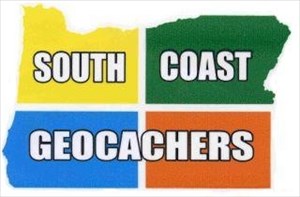Cache information:
This cache is located in a serene and scenic location that serves as an eternal view for some of Bandon's historical figures. Please don't step into the ivy to look for the cache.
It can be reached from the grass.
Location information:
Not only is there a spectacular view of Bandon Old Town and the mouth of the Coquille River but there is over one hundred years of Bandon history in the Averill Pioneer Cemetery. You will see many “Pioneer Cemeteries” in this area of Oregon. There was a major westward movement that began in the mid-1800s. By 1850, the Oregon Trail was being used so much, unrelated wagon trains would often be within sight of each other.
Although the city of Bandon was founded by the Averill family, it was named by George Bennett who came to Oregon from Bandon, Ireland in 1873. He was an influential early settler and is responsible for naming the city “Bandon”. The citizens of the area incorporated under that name in 1891. George Bennett is buried in plot #70 which is right on the bluff to the left of the cemetery road. Look for a fairly large tombstone.
One of the larger plots, about 24 feet square is directly back from George Bennett’s plot about 100 feet. You will see the name “Gallier” on many of the headstones. The Galliers were one of the early families in the area and owned the Hotel Gallier among other businesses. There is a Hotel Gallier plaque on First Street as you go west out of Old Town on First Street towards the Port Building. The Hotel Gallier burned down in the 1936 fire that destroyed most of Bandon. At one time it was the largest hotel in Bandon.
Another section of the cemetery is the G.A.R. section. There is a tall monument that marks the G.A.R. section. It was erected by the G.A.R. and the ladies auxiliary, the W.R.C. The G.A.R. was an organization called the “Grand Army of the Republic” and was a very powerful national organization of Civil War Union Army veterans. It was formed in 1866 and was influential in matters of veteran’s rights as well as politics. Five U.S. presidents were members of the G.A.R.
You will see several graves that are not marked with the veteran's date of death but with his rank, company, and unit number. That seems to be a military tradition. It is interesting that so many of the graves are for people from the “7th Tennessee Mounted Infantry” or “Company H, 68th New York Infantry”. These men picked up stakes after the war and moved west to find their fortunes.
One of the graves belongs to John Pottorff. The unusual spelling of the name made it possible to pinpoint his records; he was from Illinois. The state of Illinois keeps meticulous records of its military. The tombstone indicates that John P. was in Company H of the 41st Illinois Infantry. A search of the Illinois database turned up the following information about John Pottorff when he enlisted:
John W. Pottorff
Residence: Shelby County
Regiment: 41st Illinois Infantry, Company H
Rank: Private
Age: 28 years old
Height: 6 foot, 1 inch
Hair color: Dark
Eye color: Gray
Complexion: Dark
Marital Status: Married
Occupation: Blacksmith
Nativity: Cork (Clark?) County, Indiana
Mustered Out: Springfield
The obituary headline for John Pottorff reads “Old Soldier Found Dead”. He died in 1911 at the age of 81. He had been living outside of town in a cabin near the Queen Anne section of Bandon (on Beach Loop Road) and was dead 10 or more days before the body was found. His tombstone is in the G.A.R. section by the large stand of trees.
Clayton B. Zeek was another Civil War veteran. His tombstone is between the G.A.R. monument and the street. According to his obituary, Mr. Zeek was “probably the leading citizen in all patriotic undertakings.” It goes on to say that he was a “large boy for his age” and that at the age of 13 he enlisted in the Union Army to serve in the Civil War.
In 1918, the world experienced an influenza epidemic. This epidemic was so widespread that it killed more people worldwide in a six-month period than World War I over a period of four years. Estimated deaths worldwide were more than 22 million people. This epidemic was different from other epidemics in that it didn’t concentrate on the elderly or the very young but rather on the 20 to 40-year-old age group. Large cities were especially hard hit due to population density. Nevertheless, Oregon, though sparsely populated was not left untouched. Mathias and Bessie Lux were a young couple with an infant son, Lowell Lux. Mathias had quit his job as a porter in a hotel in Coos Bay (Marshfield) to work at the Coos Bay Shipbuilding Company to help with the war (World War I) effort. Both he and his wife contracted the flu. Bessie died on December 16th of 1918 and Mathias died five days later. Bessie was 21; Mathias was 24. In the obituary, it says that Mathias “was thought to have been out of danger when his condition became suddenly worse and he gradually sank.” Their tombstone is to the left of the path leading through the cemetery.
Congrats to norway sprint and ST13PILOT on being FTF!
